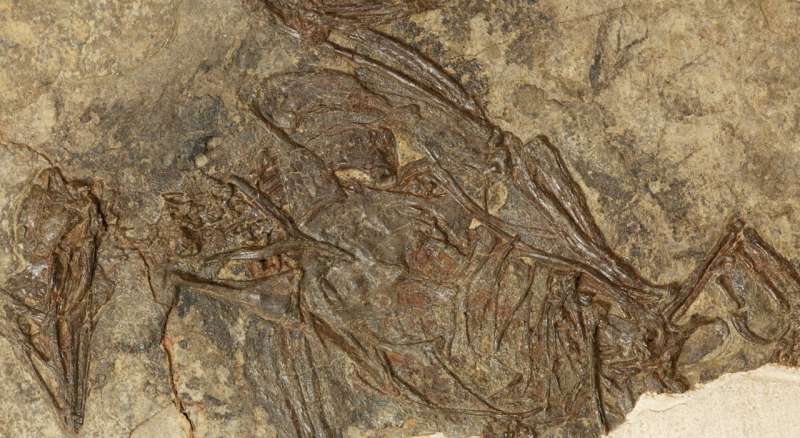October 10, 2017 report
Fossil find pushes back date of earliest fused bones in birds by 40 million years

(Phys.org)—A trio of researchers with the Key Laboratory of Vertebrate Evolution and Human Origins of Chinese Academy of Sciences has found evidence that pushes back the earliest example of fused bones in birds by approximately 40 million years. In their paper published in Proceedings of the National Academy of Sciences, Min Wang, Zhiheng Li and Zhonghe Zhou describe their study of the fossilized remains of a bird dated to approximately 120 million years ago.
In order for birds to evolve from land or tree dwelling animals into creatures that can fly, many changes had to occur—they had to become lighter while maintaining a strong skeleton. One of the ways this occurred was through fusion of bones, such as fingers into wingtips, while many other bones were simply lost to evolution. Until now, the consensus among scientists has been that such changes did not occur until just before land-based dinosaurs became extinct. But now, new evidence by the team in China suggests that the time frame will have to be pushed back approximately 40 million years—the bird now represents the oldest known example of fossilized remains showing bone fusion of its major parts.
The skeletal remains they were studying were of a bird, Pterygornis dapingfangensi (an Enantiornithe) that once lived in what is now northeastern China. It represents only the second one of its kind ever found. The researchers report that it was in very good condition, so studying it was easy. They report also that the bird very clearly had fused hands and pelvic girdle. More specifically, the fusion was seen in the ilium, the alular-major metacarpals, the ischium and in the pubis pelvis bones. They note that such fusions have rarely been reported with birds of the Early Cretaceous and that the birds appeared to have followed a growth pattern similar to that of modern birds.
The finding fills in some of the blanks that have made it difficult to follow the transition of land animals to birds due to a dearth of fossilized evidence. With the finding of the new specimen, more details about bone fusion and the evolutionary history of flight in animals are emerging.
More information: Min Wang et al. Insight into the growth pattern and bone fusion of basal birds from an Early Cretaceous enantiornithine bird, Proceedings of the National Academy of Sciences (2017). DOI: 10.1073/pnas.1707237114
Abstract
Bird skeletons exhibit remarkable modifications that allow for flight. The most distinguishable features are the fusion of the bones in the hand, feet, and pelvis into composite rigid and bony structures. However, the historical origins of these avian bone fusions remain elusive because of the rarity of transitional fossils and developmental studies on modern birds. Here, we describe an Early Cretaceous bird (120 Mya) that has fully fused alular-major metacarpals and pelvis. We discuss the manus and pelvis fusions across Paravian phylogeny and demonstrate that these features evolved independently across nonavian theropods, Enantiornithes, and Ornithuromorpha. The fusions of these bones are rare in known nonavian theropods and Early Cretaceous birds but are well established among Late Cretaceous and modern birds, revealing a complicated evolution pattern unrecognized previously. We posit that the developments of bone fusion were polymorphic close to the origin of birds, resulting in the varying degrees of fusion in Paraves. However, that development polymorphism appears to be fundamentally restricted along the line to modern birds by the Late Cretaceous, where all birds have a completely fused manus and pelvis. Such changes likely correspond to a refinement of flight capability. Alternatively, the degree of bone fusion in this primitive bird may have been related to modifications in genes or developmental paths. Future studies and fossil discoveries are required to clarify these hypotheses and pinpoint the developmental pathways involving the bone fusions in early avian evolution through to their modern pattern.
Journal information: Proceedings of the National Academy of Sciences
© 2017 Phys.org





















